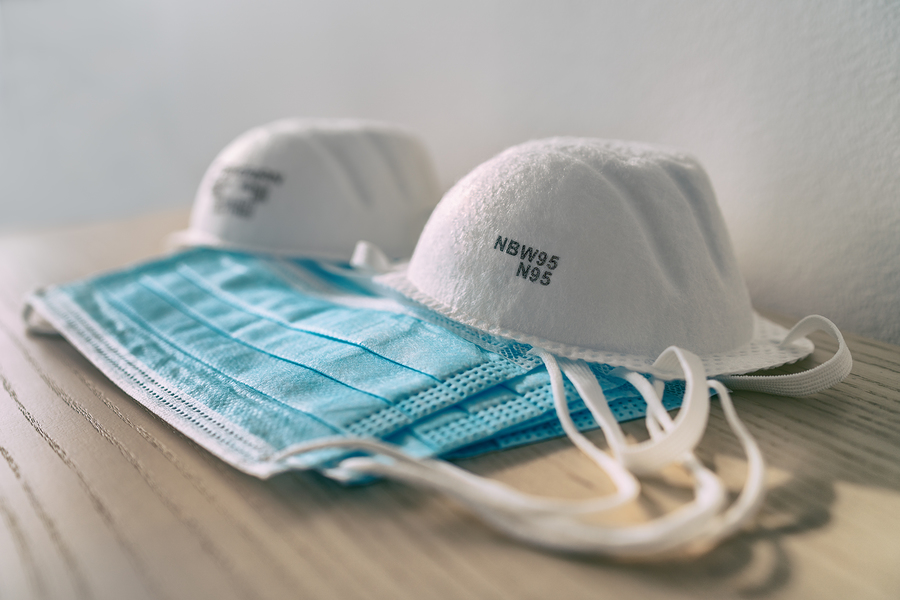Face Masks – a simple guide
Government regulations require face coverings to be worn by all hospital outpatients and visitors as well as anyone travelling on public transport in England plus shops in Scotland, and from 24th July it will be compulsory to wear a face covering in shops in England as well.
Here is what you need to know about the use of masks and coverings.
– What is a face covering?
Face coverings are not the same as face masks. The Government has stated that coverings can be made from scarves, bandanas or other fabric items, so long as they cover the mouth and nose.
They should allow the wearer to breathe comfortably and be tied behind the head to provide a “snug fit”.
Officials have said people can make their own coverings at home using T-shirts or cotton fabric and string.
– Why are they being recommended?
The Government states that, while wearing a face covering does not protect the wearer, it may protect others if people are infected but have not yet developed symptoms.
People wearing a covering should wash their hands before putting it on and after taking it off.
It should also be washed regularly in the laundry with detergent, the Government said.
– When should I wear a face covering?
According to new World Health Organisation (WHO) advice, face coverings should be worn in public whenever social distancing is not possible, especially if you are over 60-years-old or have an underlying health condition.
– Are there any specific locations that require me to wear a face covering?
All hospital visitors and outpatients are required to wear face coverings and all hospital staff are required to wear surgical masks, and also by anyone using public transport.
All airlines have also introduced a requirement for passengers to wear face masks during all flights.
It is now mandatory to wear a face covering in shops in Scotland, and from 24th July it will be compulsory to wear a face covering in shops in England as well.
The advice reads: “The evidence suggests that wearing a face covering does not protect you, but it may protect others if you are infected but have not developed symptoms.
“If you have symptoms of Covid-19 (cough and/or high temperature) you and your household should isolate at home: wearing a face covering does not change this.”
It adds that the recommended face coverings are not the same as the surgical masks used by healthcare staff and other workers.
“Face coverings should not be used by children under the age of two or those who may find it difficult to manage them correctly, for example primary school age children unassisted, or those with respiratory conditions,” the guidance continues.
“It is important to use face coverings properly and wash your hands before putting them on and taking them off.”
There are differences between the performance and protection of each type of mask and ere we look at the difference between a variety of face coverings that are available:
Cloth Masks or Face Coverings

We are now being advised that homemade masks and face coverings could help to limit the transmission of Covid-19 where social distancing is difficult, especially on public transport and in shops. Homemade masks are less effective than medical masks at preventing the wearer from transmitting the virus so it is important to understand their limitations and continue to adhere to the Government’s social distancing rules and advice on hand washing and avoiding touching the mask or face.
Cloth masks are very easy to make with even no-sew options available. How to make your own face mask
Surgical face masks

Surgical medical masks are used in hospital and healthcare settings and are for use in protecting others from the wearer transmitting infection. There are four main types:
- Type I Face Mask
- Type I R Face Mask
- Type II Face Mask
- Type II R Face Mask
They differ in their bacterial filtration efficiency from 95 to 98% and in thickness and comfort. The breathing resistance, and splash resistance for Type I R and Type II R masks, are exactly the same.
Surgical masks of this type stop the wearer from infecting the surrounding environment. They are not effective at protecting the wearer from airborne diseases such as coronavirus.
Save 10% on face masks with HARTMANN, trusted supplier to the NHS for over 30 years
Respirator Masks
These respirators meet the guidelines from the World Health Organisation for protection against Covid-19 and are worn in ICU hospital units.
- FFP2 Face Mask (equivalent of N95)*
- FFP3 Face Mask
FFP2 & FFP3 Face Masks are European classes of respirators, tested on the direction of inspiration (outside to inside) and take into account leakage to the face and filtration efficiency. These and other respirator masks, including N95 are effective at protecting the wearer from viral transmission.
*N95 masks cannot be officially legally recommended for use in healthcare settings in Europe although in the current situation with PPE shortages in practice a more flexible approach seems to be being taken.
COVAFLU offer 15% off FFP2 facemasks
Disclaimer
All content on Silversurfers.com is provided for general information only, and should not be treated at all as a substitute for the medical advice of your own doctor or any other health care professional. Silversurfers will not be responsible or liable for any diagnosis made by a user based on the content on www.silversurfers.com and we are also not liable for the content of any external websites or links from or to Silversurfers to any other websites. Please always consult your own doctor if you’re in any way concerned about any aspect of your health.






















